I could only remember that Heather had blogged about it blooming in her zone 7 Portland garden in spring, which turns out is all I needed to remember.
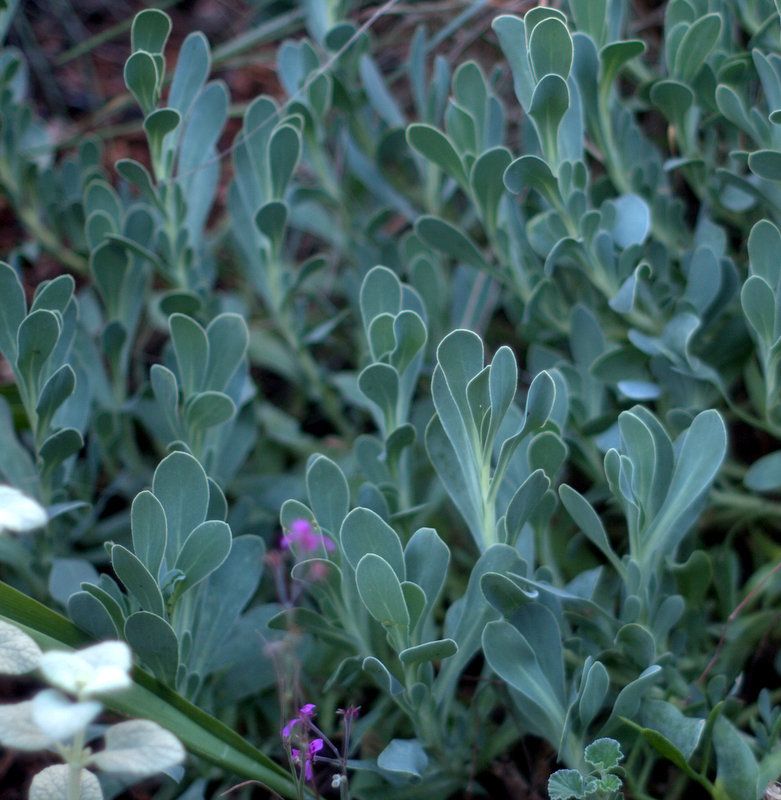
Othonna cheirifolia, native to South Africa, chalky blue, spatulate leaves, going by the piratical-sounding common name of Barbary Ragwort.
Small yellow daisies in spring are less compelling than the carpet of glaucous leaves that remains year-round in my zone 10.
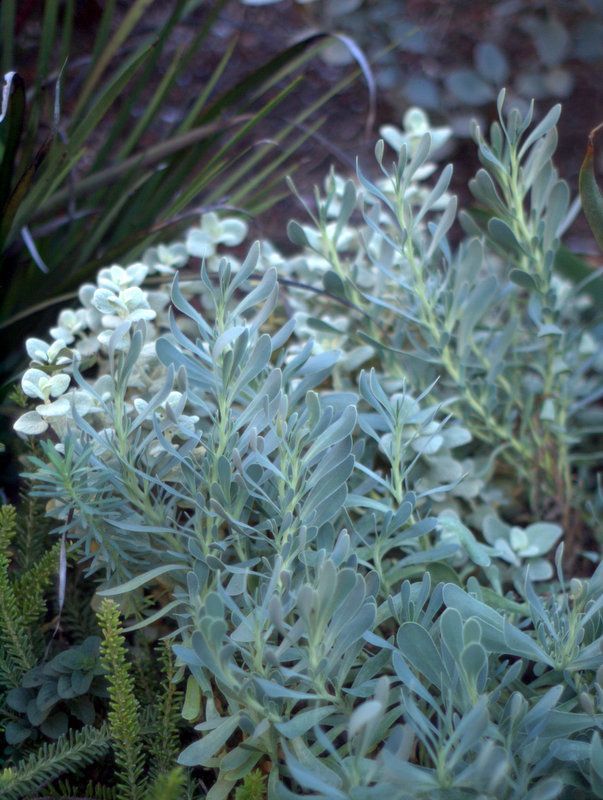
To get a sense of just how blue othonna is, see its chalky blueness growing next to bright green Grevillea ‘Mt. Tamboritha.’ White felty leaves of ballota in the background.
Together with their strikingly blue color, the slender, smooth-edged, spoon-shaped leaves effortlessly set themselves apart in a jumble community of plants.
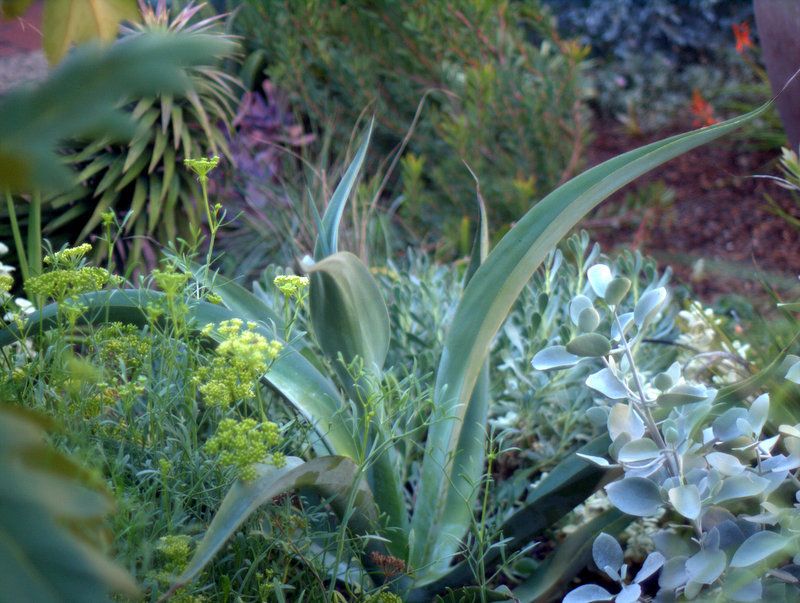
Growing at the base of a young Octopus agave (A. vilmoriniana), it’s had as much sun and irrigation as the agave — scorching in regards to the former, spotty with the latter.
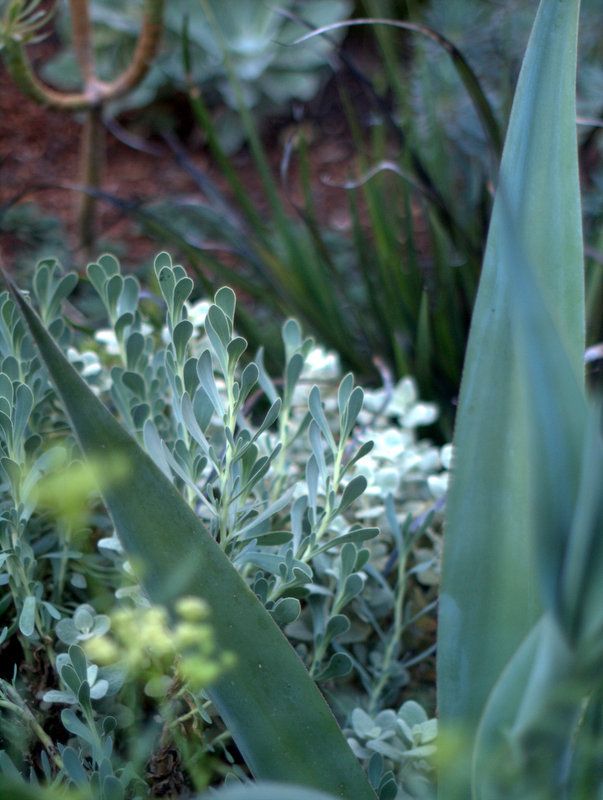
Leaf color just about matches the agave too.
On 12/7/12 I blogged that it was “just found today,” so this is almost a three-year-old clump.
If you’re after blue at a galloping pace, there’s always Senecio mandraliscae, the Blue Chalk Fingers.
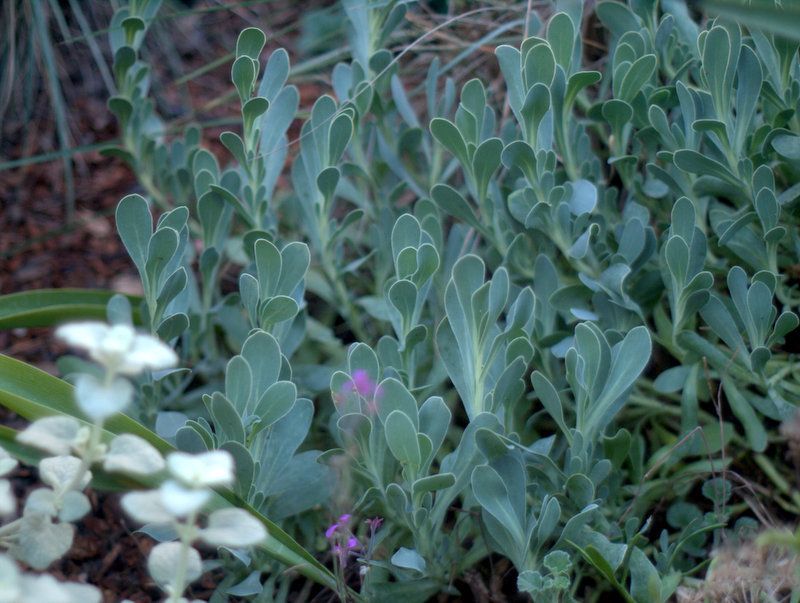
A subtle but remarkably durable plant with a tricky name to remember.
(There’s another othonna with the memorable common name of Little Pickles, a small-scale ground cover with blue succulent leaves, Othonna capensis.)
Othonna, Othonna, Othonna. There…committed to memory at last.

Pretty plant. Senecio mandraliscae has proven too aggressive for me, and pulling it out–oy–it weighs a ton.
Nice plant. Do you remember where you found it?
Othonna!
I learned of its existence almost 20 years ago, but have hardly ever seen it anywhere since, in person or in pictures. It was a picture and accompanying plant key that riveted me in Gardening at Sissinghurst (Tony Lord): A bed in the Cottage Garden with hot-colored flowers also had a good amount of glaucous foliage — spiky bearded iris echoing the color but contrasting with the shape of mysterious round bluish pads: Othonna.
So happy to know more about it and see more of it.
Never seem to see Othonnas used much in gardens here in the Bay Area, will have to remedy that.
@Hoov, same here with that senecio. And the nicely mannered version, Senecio serpens, never seems to make a solid group, just withers away.
@Kris, judging from that Dec 2012 post, I assume I found it at Lincoln Ave Nursery in Pasadena. I’ve never seen it available since.
@Nell, yes, Vita would have known of it possibly through Gertrude Jekyll’s writings, which is where I first learned of it.
@David, the Little Pickles seems suited more for a container, a bit dainty for the garden. I do see that othonna for sale occasionally.
The timing of this post is bizarre! I read it last night on my iPad before falling asleep, too sleepy to reply then. Earlier in the day, while working on a post for plant lust (http://plantlust.com/blog/2015/11/change-doesnt-always-mean-change-and-thats-a-good-thing/) I spent quite awhile trying to find the name of this plant! I finally gave up. The only places I’ve seen it growing are in the garden I was writing about, mine and Heather’s.
Oh and if you’re wanting more (or you Kris) Cistus is where I bought mine, and they do mail order!
This definitely needs to be in more dry gardens. Just looked it up at The Plant List, which has a link to the page from Linnaeus that describes it — recorded from natural habitat in Ethiopia.(!) Didn’t realize it had been known to Europeans for so long. Off to find some discussion in Jekyll; Surrey doesn’t strike me as an ideal setting to grow it, but Othonna’s distinctive good looks make it completely understandable why painting gardeners would want to use it.
Othonna cheirifolia, definitely a name to remember!
I also find Senecio mandraliscae too rascally. I’ve been trying to find Senecio serpens as an alternative but it seems like I shouldn’t even bother. Othonna cheirifolia is the way to go.
Found at both Plant Delights and Far Reaches. I must have it.
I’ve found both Senecio mandraliscae and S. serpens to work well as massed groundcovers in the right conditions. S. serpens will mass well here in milder parts of the Bay Area, but needs full winter sun and excellent drainage and minimal frost to keep looking good. Much less clipping to restrain size where it’s adapted to the conditions. I also do like S. mandraliscae for massed plantings, but have learned to keep it tip pinched 2~3 times a year to keep looking neat, and don’t use it next to slower/smaller growing neighbors likely to be smothered. I don’t have the patience to plant one gallons at 3′ centers, so generally instead plant as rooted cuttings at 1′ centers. Then I may rip out and replant after 5 years if I haven’t kept up with pruning or too much shade has made it leggy.
@Nell, I learned of both this othonna and Crambe maritima from Jekyll, so in both instances success in Surrey translates into success in 21st century SoCal!
@Gerhard, see David’s note, but, again, we all know Davis is not the Bay Area.
@Kathy, thanks for the info!
@David, it’d be great if a less labor intensive method than pinching by hand could tame S. mandraliscae. Maybe an electric-powered weed strimmer applied once or twice a year? This senecio would seem to be preferable to the increasingly prevalent large swathes of gravel.
Just for the record, it is also tolerant of Southern muggy heat and humidity, as long as it is planted in dry soil.
@Les: Othonna is tolerant of heat and humidity as long as soil is dry? Or the Senecio?
@Les, I noted othonna in your April 2015 bloom day report, thanks.
@Nell, Les was referring to the othonna. I visited the LA Arboretum today and noted the othonna’s use as a ground cover under aloes! Blistering full sun.